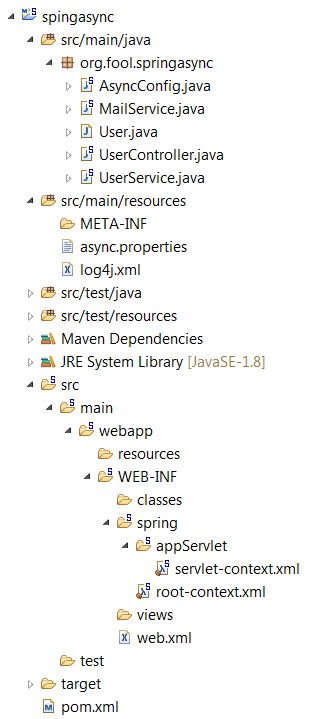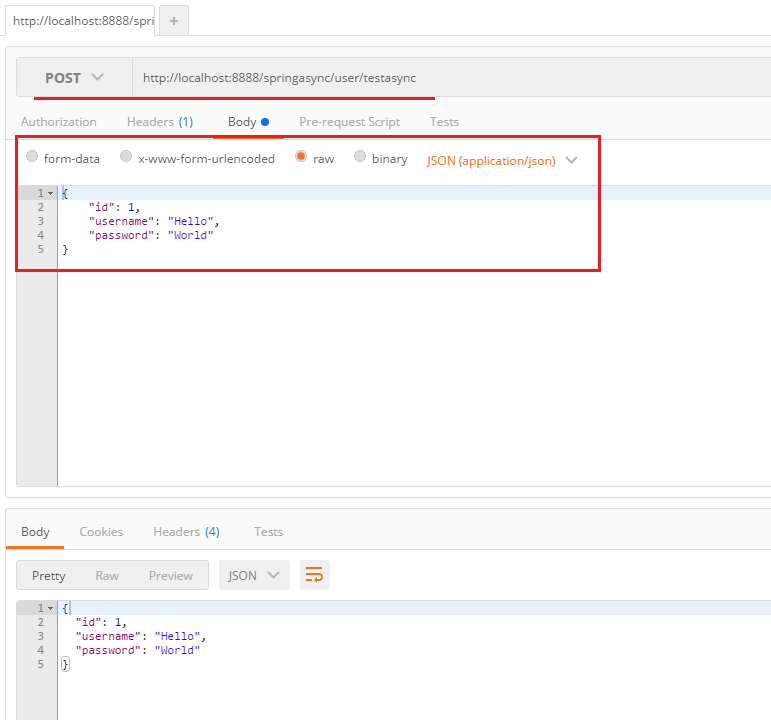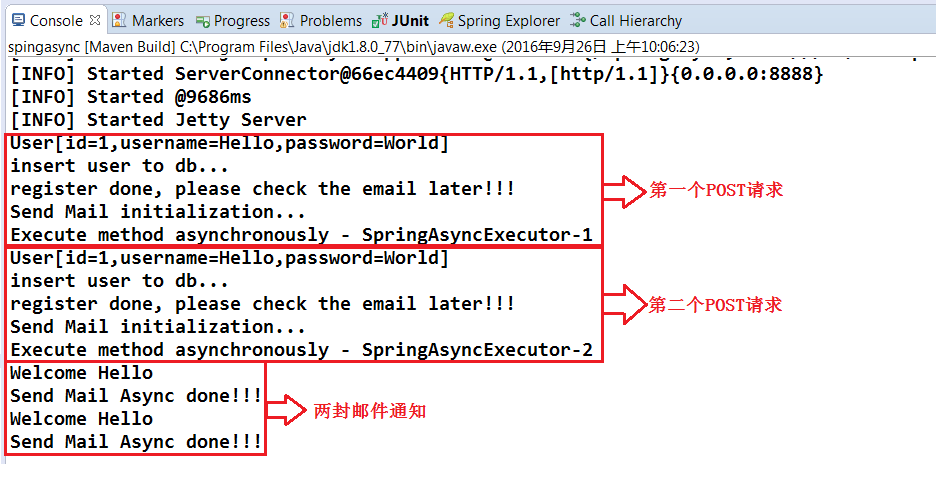Spring开启@Async异步(javaconfig配置)
在Spring中,基于@Async标注的方法,称之为异步方法;这些方法将在执行的时候,将会在独立的线程中被执行,调用者无需等待它的完成,即可继续其他的操作。
应用场景
- 某些耗时较长的而用户不需要等待该方法的处理结果
- 某些耗时较长的方法,后面的程序不需要用到这个方法的处理结果时
代码
创建AsyncTask
/**
* 异步任务
*
* @author Peng
*/
public class AsyncTask {
@Async
public void doAsyncTask() throws InterruptedException {
// 假设执行一个很耗时的任务
Thread.sleep(10 * 1000);
System.out.println("执行完成,我执行了10秒");
}
}
创建spring配置AppConfig
/**
* spring 配置
*
* @author Peng
*/
@Configuration
@EnableAsync
public class AppConfig {
/**
* 声明异步任务bean
*
* @return
*/
@Bean
public AsyncTask asyncTask() {
return new AsyncTask();
}
}
测试
/**
* 异步测试
*
* @author Peng
*/
public class AppTest {
public static void main(String[] args) throws InterruptedException {
ApplicationContext ctx = new AnnotationConfigApplicationContext(AppConfig.class);
AsyncTask task = ctx.getBean(AsyncTask.class);
task.doAsyncTask();
System.out.println("异步任务调用成功,返回客户端执行成功,异步任务继续执行");
}
}
执行结果
异步任务调用成功,返回客户端执行成功,异步任务继续执行
执行完成,我执行了10秒
从结果可以看出,异步任务测试成功!
Spring @Async Demo
模拟一个业务场景:系统新用户注册成功后,异步发送邮件。
Project Directory

Maven Dependency
<?xml version="1.0" encoding="UTF-8"?>
<project xmlns="http://maven.apache.org/POM/4.0.0" xmlns:xsi="http://www.w3.org/2001/XMLSchema-instance"
xsi:schemaLocation="http://maven.apache.org/POM/4.0.0 http://maven.apache.org/maven-v4_0_0.xsd">
<modelVersion>4.0.0</modelVersion>
<groupId>org.fool.springasync</groupId>
<artifactId>springasync</artifactId>
<name>springasync</name>
<packaging>war</packaging>
<version>1.0.0-BUILD-SNAPSHOT</version>
<properties>
<org.springframework-version>4.2.8.RELEASE</org.springframework-version>
</properties>
<dependencies>
<!-- Spring -->
<dependency>
<groupId>org.springframework</groupId>
<artifactId>spring-context</artifactId>
<version>${org.springframework-version}</version>
</dependency>
<dependency>
<groupId>org.springframework</groupId>
<artifactId>spring-webmvc</artifactId>
<version>${org.springframework-version}</version>
</dependency>
<dependency>
<groupId>com.fasterxml.jackson.core</groupId>
<artifactId>jackson-databind</artifactId>
<version>2.8.1</version>
</dependency>
<dependency>
<groupId>com.google.guava</groupId>
<artifactId>guava</artifactId>
<version>19.0</version>
</dependency>
<dependency>
<groupId>org.apache.commons</groupId>
<artifactId>commons-lang3</artifactId>
<version>3.4</version>
</dependency>
<!-- @Inject -->
<dependency>
<groupId>javax.inject</groupId>
<artifactId>javax.inject</artifactId>
<version>1</version>
</dependency>
<!-- Servlet -->
<dependency>
<groupId>javax.servlet</groupId>
<artifactId>javax.servlet-api</artifactId>
<version>3.1.0</version>
<scope>provided</scope>
</dependency>
<dependency>
<groupId>javax.servlet.jsp</groupId>
<artifactId>javax.servlet.jsp-api</artifactId>
<version>2.3.1</version>
<scope>provided</scope>
</dependency>
<dependency>
<groupId>javax.servlet</groupId>
<artifactId>jstl</artifactId>
<version>1.2</version>
</dependency>
<!-- Test -->
<dependency>
<groupId>junit</groupId>
<artifactId>junit</artifactId>
<version>4.12</version>
<scope>test</scope>
</dependency>
</dependencies>
<build>
<plugins>
<plugin>
<groupId>org.apache.maven.plugins</groupId>
<artifactId>maven-eclipse-plugin</artifactId>
<version>2.10</version>
<configuration>
<additionalProjectnatures>
<projectnature>org.springframework.ide.eclipse.core.springnature</projectnature>
</additionalProjectnatures>
<additionalBuildcommands>
<buildcommand>org.springframework.ide.eclipse.core.springbuilder</buildcommand>
</additionalBuildcommands>
<downloadSources>true</downloadSources>
<downloadJavadocs>true</downloadJavadocs>
</configuration>
</plugin>
<plugin>
<groupId>org.apache.maven.plugins</groupId>
<artifactId>maven-compiler-plugin</artifactId>
<version>3.5.1</version>
<configuration>
<source>1.8</source>
<target>1.8</target>
<compilerArgument>-Xlint:all</compilerArgument>
<showWarnings>true</showWarnings>
<showDeprecation>true</showDeprecation>
</configuration>
</plugin>
<plugin>
<groupId>org.eclipse.jetty</groupId>
<artifactId>jetty-maven-plugin</artifactId>
<version>9.3.11.v20160721</version>
<configuration>
<scanIntervalSeconds>10</scanIntervalSeconds>
<httpConnector>
<port>8888</port>
</httpConnector>
<webApp>
<contextPath>/springasync</contextPath>
</webApp>
</configuration>
</plugin>
</plugins>
</build>
</project>
web.xml
<?xml version="1.0" encoding="UTF-8"?> <web-app xmlns:xsi="http://www.w3.org/2001/XMLSchema-instance" xmlns="http://java.sun.com/xml/ns/javaee" xmlns:web="http://java.sun.com/xml/ns/javaee/web-app_3_0.xsd" xsi:schemaLocation="http://java.sun.com/xml/ns/javaee http://java.sun.com/xml/ns/javaee/web-app_3_0.xsd" id="WebApp_ID" version="3.0"> <!-- The definition of the Root Spring Container shared by all Servlets and Filters --> <context-param> <param-name>contextConfigLocation</param-name> <param-value>/WEB-INF/spring/root-context.xml</param-value> </context-param> <!-- Creates the Spring Container shared by all Servlets and Filters --> <listener> <listener-class>org.springframework.web.context.ContextLoaderListener</listener-class> </listener> <!-- Processes application requests --> <servlet> <servlet-name>appServlet</servlet-name> <servlet-class>org.springframework.web.servlet.DispatcherServlet</servlet-class> <init-param> <param-name>contextConfigLocation</param-name> <param-value>/WEB-INF/spring/appServlet/servlet-context.xml</param-value> </init-param> <load-on-startup>1</load-on-startup> </servlet> <servlet-mapping> <servlet-name>appServlet</servlet-name> <url-pattern>/</url-pattern> </servlet-mapping> </web-app>
root-context.xml
<?xml version="1.0" encoding="UTF-8"?> <beans xmlns="http://www.springframework.org/schema/beans" xmlns:xsi="http://www.w3.org/2001/XMLSchema-instance" xsi:schemaLocation="http://www.springframework.org/schema/beans http://www.springframework.org/schema/beans/spring-beans.xsd"> <!-- Root Context: defines shared resources visible to all other web components --> </beans>
servlet-context.xml
<?xml version="1.0" encoding="UTF-8"?>
<beans:beans xmlns="http://www.springframework.org/schema/mvc" xmlns:xsi="http://www.w3.org/2001/XMLSchema-instance"
xmlns:beans="http://www.springframework.org/schema/beans" xmlns:context="http://www.springframework.org/schema/context"
xmlns:task="http://www.springframework.org/schema/task"
xsi:schemaLocation="http://www.springframework.org/schema/mvc http://www.springframework.org/schema/mvc/spring-mvc.xsd
http://www.springframework.org/schema/beans http://www.springframework.org/schema/beans/spring-beans.xsd
http://www.springframework.org/schema/context http://www.springframework.org/schema/context/spring-context.xsd
http://www.springframework.org/schema/task http://www.springframework.org/schema/task/spring-task.xsd">
<!-- DispatcherServlet Context: defines this servlet's request-processing infrastructure -->
<!-- Enables the Spring MVC @Controller programming model -->
<annotation-driven />
<!-- Handles HTTP GET requests for /resources/** by efficiently serving up static resources in the ${webappRoot}/resources
directory -->
<resources mapping="/resources/**" location="/resources/" />
<!-- Resolves views selected for rendering by @Controllers to .jsp resources in the /WEB-INF/views directory -->
<beans:bean class="org.springframework.web.servlet.view.InternalResourceViewResolver">
<beans:property name="prefix" value="/WEB-INF/views/" />
<beans:property name="suffix" value=".jsp" />
</beans:bean>
<context:component-scan base-package="org.fool.springasync" />
</beans:beans>
AsyncConfig.java
package org.fool.springasync;
import java.util.concurrent.Executor;
import java.util.concurrent.ThreadPoolExecutor;
import org.springframework.beans.factory.annotation.Value;
import org.springframework.context.annotation.Bean;
import org.springframework.context.annotation.Configuration;
import org.springframework.context.annotation.PropertySource;
import org.springframework.context.support.PropertySourcesPlaceholderConfigurer;
import org.springframework.scheduling.annotation.EnableAsync;
import org.springframework.scheduling.concurrent.ThreadPoolTaskExecutor;
@Configuration
@EnableAsync
@PropertySource("classpath:async.properties")
public class AsyncConfig {
/** Set the ThreadPoolExecutor's core pool size. */
@Value("${core.pool.size}")
private Integer corePoolSize;
/** Set the ThreadPoolExecutor's maximum pool size. */
@Value("${max.pool.size}")
private Integer maxPoolSize;
/** Set the capacity for the ThreadPoolExecutor's BlockingQueue. */
@Value("${queue.capacity}")
private Integer queueCapacity;
@Value("${thread.name.prefix}")
private String ThreadNamePrefix;
@Bean
public static PropertySourcesPlaceholderConfigurer propertySourcesPlaceholderConfig() {
return new PropertySourcesPlaceholderConfigurer();
}
@Bean
public Executor getAsyncExecutor() {
ThreadPoolTaskExecutor executor = new ThreadPoolTaskExecutor();
executor.setCorePoolSize(corePoolSize);
executor.setMaxPoolSize(maxPoolSize);
executor.setQueueCapacity(queueCapacity);
executor.setThreadNamePrefix(ThreadNamePrefix);
// rejection-policy:当pool已经达到max size的时候,如何处理新任务
// CALLER_RUNS:不在新线程中执行任务,而是有调用者所在的线程来执行
executor.setRejectedExecutionHandler(new ThreadPoolExecutor.CallerRunsPolicy());
executor.initialize();
return executor;
}
}
Note:
AsyncConfig使用Annotation进行Spring Async的配置,当然也可以用XML的方式进行配置,只需要在servlet-context.xml中添加task的命名空间,同时加下如下两行配置:
<!-- Enables Spring Async --> <task:annotation-driven executor="asyncExecutor"/> <task:executor id="asyncExecutor" pool-size="2-4" queue-capacity="10"/>
<task:executor />配置参数:
id:当配置多个executor时,被@Async("id")指定使用;也被作为线程名的前缀。
pool-size:
- core size:最小的线程数,缺省:1
- max size:最大的线程数,缺省:Integer.MAX_VALUE
queue-capacity:当最小的线程数已经被占用满后,新的任务会被放进queue里面,当这个queue的capacity也被占满之后,pool里面会创建新线程处理这个任务,直到总线程数达到了max size,这时系统会拒绝这个任务并抛出TaskRejectedException异常(缺省配置的情况下,可以通过rejection-policy来决定如何处理这种情况)。缺省值为:Integer.MAX_VALUE
keep-alive:超过core size的那些线程,任务完成后,再经过这个时长(秒)会被结束掉
rejection-policy:当pool已经达到max size的时候,如何处理新任务
- ABORT(缺省):抛出TaskRejectedException异常,然后不执行
- DISCARD:不执行,也不抛出异常
- DISCARD_OLDEST:丢弃queue中最旧的那个任务
- CALLER_RUNS:不在新线程中执行任务,而是有调用者所在的线程来执行
MailService.java
package org.fool.springasync;
import org.springframework.scheduling.annotation.Async;
import org.springframework.stereotype.Component;
@Component
public class MailService {
@Async
public void sendMail(String username) {
System.out.println("Send Mail initialization...");
System.out.println("Execute method asynchronously - " + Thread.currentThread().getName());
try {
Thread.sleep(5000);
System.out.println("Welcome " + username);
} catch (InterruptedException e) {
e.printStackTrace();
}
System.out.println("Send Mail Async done!!!");
}
}
User.java
package org.fool.springasync;
import org.apache.commons.lang3.builder.ToStringBuilder;
import org.apache.commons.lang3.builder.ToStringStyle;
public class User {
private Long id;
private String username;
private String password;
public User() {
}
public User(Long id, String username, String password) {
this.id = id;
this.username = username;
this.password = password;
}
public Long getId() {
return id;
}
public void setId(Long id) {
this.id = id;
}
public String getUsername() {
return username;
}
public void setUsername(String username) {
this.username = username;
}
public String getPassword() {
return password;
}
public void setPassword(String password) {
this.password = password;
}
@Override
public String toString() {
return ToStringBuilder.reflectionToString(this, ToStringStyle.SHORT_PREFIX_STYLE);
}
}
UserService.java
package org.fool.springasync;
import javax.inject.Inject;
import org.springframework.stereotype.Service;
@Service
public class UserService {
@Inject
private MailService mailService;
public void registerUser(User user) {
System.out.println("insert user to db...");
mailService.sendMail(user.getUsername());
System.out.println("register done, please check the email later!!!");
}
}
UserController.java
package org.fool.springasync;
import javax.inject.Inject;
import org.springframework.stereotype.Controller;
import org.springframework.web.bind.annotation.RequestBody;
import org.springframework.web.bind.annotation.RequestMapping;
import org.springframework.web.bind.annotation.RequestMethod;
import org.springframework.web.bind.annotation.ResponseBody;
@Controller
@RequestMapping("/user")
public class UserController {
@Inject
private UserService userService;
@RequestMapping(value = "/testasync", method = RequestMethod.POST)
@ResponseBody
public User register(@RequestBody User user) {
System.out.println(user);
userService.registerUser(user);
return user;
}
}
Test
http://localhost:8888/springasync/user/testasync
POST请求(send两次)

Console Output

以上为个人经验,希望能给大家一个参考,也希望大家多多支持自学编程网。

- 本文固定链接: https://zxbcw.cn/post/221001/
- 转载请注明:必须在正文中标注并保留原文链接
- QQ群: PHP高手阵营官方总群(344148542)
- QQ群: Yii2.0开发(304864863)
